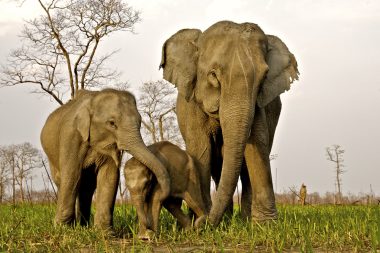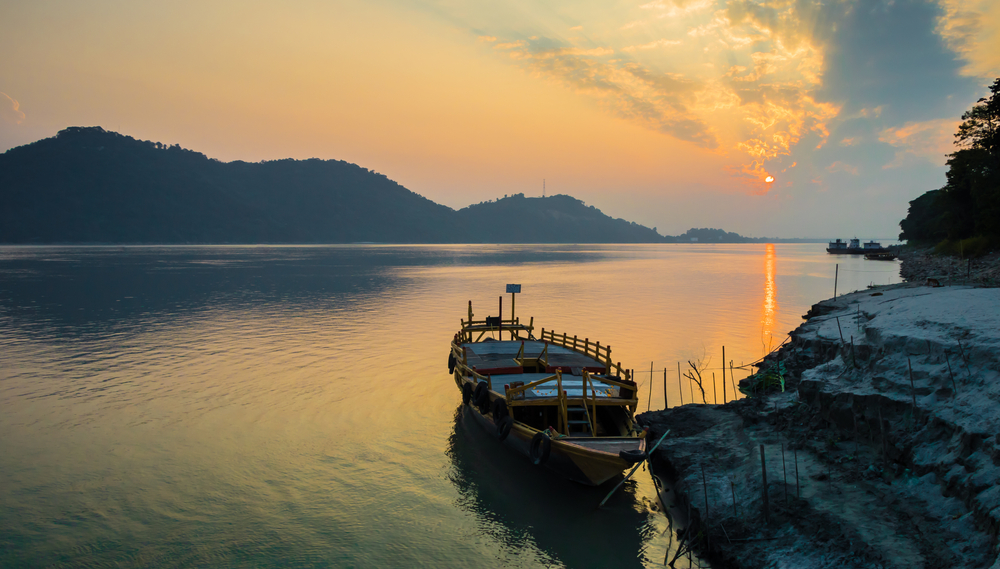The Brahmaputra, in German “son of Brahma”, is one of the largest rivers in the world. It rises in the Himalayas in Tibet and flows through China, India and Bangladesh. On the way, it is fed by numerous bodies of water and changes its name several times. From the roof of the world at an altitude of 5200 meters, the river makes its way to the Bay of Bengal to flow into the Indian Ocean in the world’s largest coastal delta. On the long journey from its source to its mouth, the Brahmaputra covers a distance of 3100 kilometers through multifaceted landscapes and cultures. Among other things, it crosses the Assam Valley in India.
Setting off for new shores in a floating hotel
The magic and multifaceted nature of India is revealed on a cruise along the banks of the Brahmaputra. While passengers immerse themselves in an exciting and exotic world and discover its beauties, they enjoy the advantages and luxury of a comfortable cruise ship as well as a pleasant atmosphere and reliable accommodation. On the journey to new destinations and impressions, the hotel always travels with you. The Brahmaputra adventure can be experienced in a relaxed way on a river cruise.
The fascinating journey leads through the country’s incomparable nature with imposing landscapes, dense jungle and green forests. In the Assam Valley there are ten national parks and wildlife sanctuaries such as the well-known Kaziranga National Park. In addition, you will get to know the rich culture of India while visiting cities steeped in history.
On safari in Kaziranga National Park

In the districts of Golaghat and Nagoan in the northern Indian state of Assam lies the Kaziranga National Park, one of the most beautiful places in India. It was founded in 1904 and 68 years later it was declared a national park. Since 1985, the park has been a UNESCO World Heritage Site. It has an area of more than 900 square kilometers and consists of tall grasslands, tropical forests and swamps as well as extensive elephant grasslands. In the north and east, the protected area is bordered by the Brahmaputra. It is the habitat for numerous rare animal species, including wild water buffalo, river dolphins, Asian elephants, Bengal tigers and Barasing deer. In addition, the park is one of the last protected areas of the Indian rhinoceros and is home to over 70% of the world’s total population. A safari in a jeep or on the back of an elephant allows visitors to get up close and personal with wild animals such as monkeys and tigers. It is also worth visiting the tea gardens and the villages of the rural tribes of the Karbi and the Mising on Majuli, the largest river island in the world.
Temples, palaces and historical sites line the path of river cruisers in India
Silghat, the town on the southern bank of the Brahmaputras, is the gateway to Kaziranga National Park and the Butterfly Forest. Last but not least, the breathtaking beauty of the surrounding landscape makes the place an attraction for numerous tourists.
Guwahati is the capital of the northeastern state of Assam. The metropolis between the picturesque hills of the Himalayan mountains is known as the gateway to northeastern India. Located on Nilachal Hill, Kamakhya Devi Temple is one of the most interesting sights.
It was built in the 10th century by King Naranarayan. Above Kamakhya is the smaller temple Bhubaneshwari, which offers a spectacular view of the city. On Mount Bhasmacala, on an island in the middle of the Brahmaputra, stands the Umananda Temple, built by King Gadadhar Singha. The State Museum, the Anthropological Museum, the Forest Museum and the Museum of Home Industry are treasure troves of Assam’s rich cultural past.
On the north bank of the mighty Brahmaputra River lies the beautiful city of Tezpur, the cultural center of Assam with a rich history. Worth seeing include the Da-Parbatia, one of the oldest and most beautiful collections of sculptural art in Assam, and the ruins of the Bamuni hill from the 9. and 10th century. The area is also famous for its tea plantations and hilly tea gardens.
One of India’s holiest pilgrimage centers is the Shiva Dol Temple from the Ahom Dynasty in Sibsagar. Its seven-foot-high dome, called Kolosi, is made of pure gold. Walls and columns inside the temple are decorated with figures and images of Hindu gods and goddesses.
Tea and silk on the banks of the river
Assam is known not least for the cultivation of tea. Especially in the valley of the Brahmaputra there are numerous tea plantations that produce the famous Assam tea. On a tour you will learn interesting details about tea production.
Sualkuchi, a tranquil village on the north bank of the Brahmaputra River, is the centre of textile production in Assam. For this reason, the silk weaving village is also known as the Manchester of India. The fine Assam silk is not produced anywhere else in the world. The place worth seeing with the rustic charm and its bamboo houses has become a popular tourist destination.


